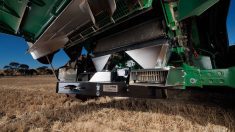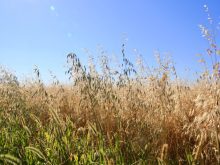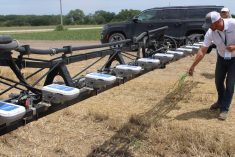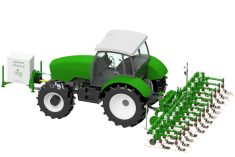[UPDATED: May 28, 2020] As resistance to our current herbicide options continues to increase each year, mechanical methods of weed control are moving into the spotlight.
The management of weeds being spread by chaff via the combine is gaining attention, and interest is growing in mechanical weed seed impact mills — one of which is already in use in Saskatchewan, reports Clark Brenzil, a provincial weed control specialist with Saskatchewan Agriculture.
Both these avenues are well developed in Australia, explains Brenzil, and while it’s unfortunate for Australian farmers that a certain weed called rigid ryegrass developed resistance to all herbicides and spurred these developments, we can adapt that country’s best ideas for use in Canada.
Read Also

Cancer agency reclassifies another herbicide ‘probably carcinogenic’
The WHO’s cancer research agency has now put atrazine, a herbicide well known to corn growers, in the same potential-hazard category where the agency put glyphosate.
“The Australians have efficient systems for burning everything that comes out of the combine, but if you do that you’re losing those nutrients, creating a huge fire risk and expelling all of that carbon to the atmosphere rather than capturing it in your soil. The next evolution is to direct the chaff away from the straw, so that you can spread the straw and funnel the chaff into a tight row,” says Brenzil.
Chaff management
There is at least one piece of equipment on the market in Australia, Brenzil explains, which directs the chaff into the wheel tracks of the combine. Using controlled traffic farming (where all the equipment runs in the same tracks in every field), they’ve found in Australia that this practice lowers weed seed bank levels between those wheel tracks.
“They draw all of the weed seed from across the cutter bar into narrow tracks behind the combine, reducing the number of weed seeds in the soil between the tracks. Weed seeds in the tracks degrade to some degree because of composting that takes place, weed seed rot and the ongoing pounding those tracks take. Some Australian producers also have their sprayers spray only the wheel tracks, since there are few, if any, weeds to spray between, saving significantly on herbicide costs,” he says.
Redekop was partnering to distribute the EMAR Chaff Deck in Western Canada, Brenzil notes. He adds there is also the option of baling the chaff with the straw right out of the combine and using this for livestock production.
Another idea is the use of chaff carts. They were initially developed in Saskatchewan, Brenzil reports, but mostly abandoned years ago and were revived in Australia in the early 2000s. The collected chaff is either fed to livestock or composted and returned to the fields.
Brenzil says the growing interest in the United States, Europe and Canada in all of this equipment means many options may be available in time to preserve our current herbicide options. “Producers have to evaluate the economics, but methods of lowering the weed seed bank are getting limited,” he says. “We also need to keep in mind that certain weed seeds don’t get caught up in the combine — low-lying weeds or weeds that drop their seeds before harvest.”

Canadian farmers can order equipment from Australia, adds Brenzil. Accounting for global supply chain issues that may persist due to the COVID-19 situation, the equipment could arrive before harvest. However, farmers could fashion their own implement that directs chaff into a narrow row. “If a person were handy with sheet metal this could be easily made, and then use the GPS system on the combine to make sure the chaff goes to the same spot every year, right under the combine or into a wheel track,” says Brenzil.
Weed seed impact mills
Brenzil also reports two models of mechanical weed seed impact mills are currently being manufactured in Australia, the Integrated Harrington Seed Destructor and the Seed Terminator *(two of these are in use north of Saskatoon). They are both fairly similar in effectiveness (above 95 per cent of weed seed is destroyed) and in price (about US$75,000).
There is also the Canadian-made Redekop Seed Control Unit, which Brenzil says costs roughly the same but also comes integrated with the MAV straw chopper and is being sold as a dealer option through John Deere dealers in 2020. All of these units draw roughly 80 to 100 horsepower, he notes, and are available on Class 7 and larger combines. There is also another brand under development in Australia, targeting the smaller and older combines, drawing under 50 horsepower and costing about C$56,000, achieving roughly 80 per cent weed kill.
Herbicide preservation
Brenzil can see a day when farmers won’t have much choice other than to buy some of this equipment. However, he hopes farmers will start to manage resistant weeds now by integrating many different control methods in order to preserve the longevity of herbicides for future use.
It’s really important to do this, he says, because the problem of herbicide resistance won’t develop as quickly on each farm. “Producers think, oh, it’s in another province, it will be awhile until it spreads here, but they need to understand that herbicide resistance is a process of evolution that has the potential to develop in every field, and they need to be proactive about its management,” says Brenzil.
*UPDATE: The feature photo caption previously included the word, ‘Harrington’. The article also previously stated that ‘one of these is in use north of Saskatoon.’ (re: Harrington Seed Destructor and the Seed Terminator).















